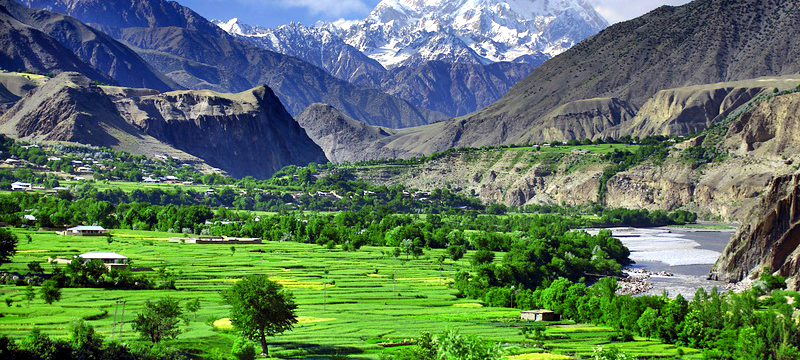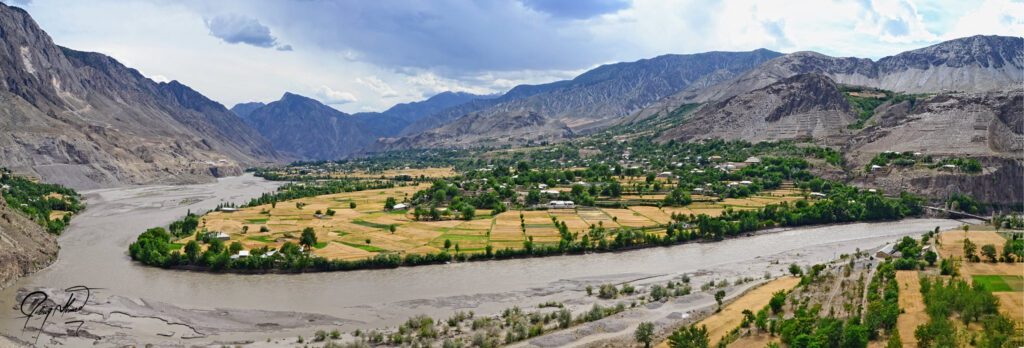Chitral, located in northwestern Pakistan, is famous for its beautiful scenery and vibrant cultural heritage. But alongside its charm, Chitral is also known for its ever-changing weather. Is Chitral Weather Good In Summer?This article will explore the fascinating world of Chitral’s weather. From its geographical location to its diverse climate, extreme conditions, and how the weather affects the lives of the people living there.
Chitral is nestled amidst the majestic mountains of the Hindu Kush range. Its geography is rugged and mountainous, with the Chitral River flowing through the valley. These towering peaks not only add to the breathtaking beauty of Chitral but also greatly influence its weather patterns.
The climate in Chitral varies widely, thanks to its different elevations and geographical features. It experiences four distinct seasons: winter, spring, summer, and autumn. Winters are long and harsh, with freezing temperatures and frequent snowfall. Spring brings warmer weather and the blossoming of flowers, while summers are mild and pleasant. Autumn paints the valley in vibrant colors as the foliage changes.
Despite its generally temperate climate, Chitral is prone to extreme weather events. Cold waves during winter can bring severe cold and heavy snowfall, disrupting daily life and causing difficulties for transportation. Occasionally, heatwaves can occur during summer, making conditions uncomfortable, especially in lower-lying areas. The region is also susceptible to flash floods, particularly during the monsoon season, which can lead to devastating consequences.
The weather in Chitral has a significant impact on the daily lives of its residents. Agriculture, which is the primary livelihood for many people, heavily depends on weather patterns. Erratic rainfall or untimely snowfall can affect crop yields, leading to financial challenges for farmers. Transportation and communication networks can also be disrupted by weather-related events like landslides or heavy snowfall. Isolating remote villages and hindering access to essential services. Additionally, the weather influences tourism in Chitral, as adverse conditions can deter visitors from exploring the valley’s beauty.
Geographical Setting Of Chitral:

Chitral, nestled in the northwestern part of Pakistan, boasts a remarkable geographical setting that captivates the imagination. It finds its place at the meeting point of three formidable mountain ranges: the Hindu Kush, Pamir, and Karakoram. This convergence bestows upon Chitral a landscape of unparalleled ruggedness and magnificence.
The valley of Chitral is cradled amidst these towering peaks, their majestic forms casting shadows and shaping the very essence of the land. The Chitral River, a lifeline for the valley’s inhabitants, weaves its way through this rugged terrain. Its journey begins high in the snow-capped peaks of the Hindu Kush. Where glaciers carve their existence into the very heart of the mountains. As the river descends from its icy origins, it becomes a vital artery, nurturing the valley and sustaining its people.
The presence of these towering peaks not only contributes to Chitral’s breathtaking beauty but also plays a pivotal role in determining its weather patterns. The geography of Chitral, with its lofty mountains and deep valleys. Creates a microcosm of climatic diversity within its relatively small expanse.
The Hindu Kush range, with its icy summits and rugged slopes. Acts as a barrier to weather systems, influencing precipitation patterns and temperature gradients. The Pamir and Karakoram ranges, with their own distinct characteristics, further contribute to the complexity of Chitral’s climate.
These mountain ranges intercept moisture-laden air masses, causing precipitation to vary significantly across different parts of the valley. The windward slopes of the mountains receive ample rainfall, fostering lush forests and verdant landscapes. While the leeward side experiences a rain shadow effect, resulting in drier conditions and arid landscapes.
The Chitral River, born from the melting glaciers of the Hindu Kush. Not only sustains life but also shapes the very contours of the valley. Its meandering course carves deep gorges and fertile valleys, leaving behind a legacy of rich alluvial soils and abundant biodiversity.
The geographical setting of Chitral, with its towering peaks, winding rivers, and rugged terrain. Is a testament to the raw power and beauty of nature. It is a land of contrasts, where snow-capped mountains meet lush valleys, and ancient traditions thrive amidst the ever-changing landscape.
Climatic Patterns And Seasons:

Chitral, with its diverse topography and varying elevations, experiences a fascinating array of climatic patterns throughout the year. Situated amidst the formidable Hindu Kush, Pamir, and Karakoram mountain ranges, the valley is subject to the whims of nature. Offering a rich tapestry of seasons and weather phenomena.
The valley predominantly exhibits a mountainous climate, characterized by distinct seasons and notable temperature fluctuations. However, within this broad classification, Chitral harbors several microclimates. Influenced by altitude, exposure to prevailing winds, and proximity to mountain ranges.
Winter:
Winter casts its icy grip over Chitral, transforming the landscape into a glistening wonderland of snow-clad peaks and frost-kissed valleys. The season is long and harsh, particularly in higher elevations, where temperatures plummet well below freezing. Snowfall is a common occurrence, blanketing the terrain in a pristine layer of white and enveloping the valley in a serene hush. Despite the challenges posed by the cold. Winter in Chitral holds a certain enchantment, drawing visitors to witness its ethereal beauty.
Spring:
As winter relinquishes its hold, spring emerges as a beacon of hope and renewal in Chitral. Warmer temperatures begin to thaw the icy grip of winter. Coaxing the landscape into a vibrant display of life and color. The gradual melting of snow gives rise to gushing streams and cascading waterfalls. While the valley bursts into a riot of blossoms and verdant foliage. Spring is a time of rejuvenation in Chitral, as the valley awakens from its wintry slumber and embraces the promise of new beginnings.
Summer:
Summer arrives in Chitral like a gentle breeze, offering respite from the harshness of winter and the fleeting beauty of spring. While summers are relatively short, they bring with them a sense of warmth and vitality to the valley. Days are characterized by pleasant temperatures, with the sun casting its golden rays upon the rugged landscape. The season provides an ideal opportunity for outdoor activities, trekking, and exploration. As Chitral reveals its hidden treasures to eager adventurers and nature enthusiasts.
Autumn:
As summer bids farewell, autumn paints the valley in a symphony of colors. Heralding the onset of a new chapter in Chitral’s seasonal cycle. The foliage begins to change, ablaze with hues of red, orange, and gold, as the valley prepares for the inevitable embrace of winter. Despite the impending chill, autumn in Chitral is a time of celebration and reflection. As the landscape transforms into a canvas of breathtaking beauty. The weather remains mild and temperate, with clear skies offering uninterrupted vistas of the surrounding mountains and valleys.
In conclusion, Chitral’s climatic patterns and seasons are a testament to the region’s natural diversity and enduring beauty. From the icy embrace of winter to the vibrant hues of autumn. Each season brings its own unique charm and allure to this enchanting valley. As the landscape transitions through the ebb and flow of the seasons, Chitral remains a timeless sanctuary. Beckoning travelers to witness the splendor of nature in all its glory.
Weather Extremes In Chitral:

Chitral, despite its overall temperate climate, is no stranger to weather extremes that can test the resilience of its inhabitants and infrastructure. Situated amidst the rugged terrain of the Hindu Kush mountains, the valley experiences a wide range of weather phenomena. From severe cold spells to intense heatwaves and torrential rains. The unique geographical setting of Chitral, characterized by its mountainous terrain. Exacerbates these extremes, leading to rapid fluctuations in weather conditions that can have profound impacts on the lives of its residents.
Cold Waves:
Winter in Chitral descends with an icy grip, often bringing severe cold waves that send temperatures plummeting well below freezing. The biting cold, coupled with heavy snowfall and blizzards, can paralyze the valley. Disrupting normal life and posing significant challenges to infrastructure and transportation networks. Remote villages, nestled amidst the snow-capped peaks. May find themselves cut off from the outside world, as snowdrifts block mountain passes and roads become impassable. Despite the hardships, Chitral’s residents have developed resilience strategies to cope with the harshness of winter. From stockpiling essential supplies to utilizing traditional heating methods to stay warm.
Heatwaves:
While summers in Chitral are generally mild, occasional heatwaves can sweep through the valley, particularly in lower-lying areas. The combination of high temperatures and low humidity levels can create uncomfortable conditions for residents and visitors alike, posing health risks. Especially for vulnerable populations. During heatwaves, Chitral’s inhabitants may seek refuge in shaded areas or cooling centers. While farmers take precautions to protect crops and livestock from heat stress. Despite the brevity of these heatwaves, their impact on daily life and well-being underscores the importance of adaptation strategies and community resilience.
Flooding:
Chitral’s susceptibility to flash floods, especially during the monsoon season. Poses a significant threat to life and property in the valley. The steep terrain, coupled with intense rainfall. Can trigger sudden and devastating floods that wreak havoc on villages and settlements along riverbanks and in low-lying areas. Flash floods, characterized by their rapid onset and destructive force, can inundate homes, wash away bridges, and disrupt vital infrastructure, leaving behind a trail of destruction and loss. In the aftermath of floods, Chitral’s residents come together to rebuild their communities, drawing upon their collective strength and resilience to overcome adversity.
Impact Of Weather On Daily Life and Economy:

The ever-changing weather patterns in Chitral exert a profound influence on the daily lives and economic activities of its residents, shaping the rhythms of life in this rugged valley. From agriculture to transportation and tourism, the impact of weather is felt across various sectors, underscoring the valley’s vulnerability to the whims of nature.
Agriculture:
Agriculture stands as the backbone of Chitral’s local economy, providing sustenance and livelihoods to a significant portion of the population. However, the success of agricultural endeavors is intricately tied to weather patterns, making farmers particularly vulnerable to the vagaries of nature. Erratic rainfall or untimely snowfall can disrupt planting schedules, stunt crop growth, and diminish yields, leading to financial hardships for farmers. The unpredictability of weather events adds an additional layer of uncertainty to agricultural practices in Chitral, compelling farmers to adopt adaptive strategies and resilience-building measures to mitigate risks and safeguard their livelihoods.
Transportation and Communication:
Chitral’s rugged terrain, characterized by steep mountains and deep valleys, poses formidable challenges to transportation and communication networks. Weather-related events such as landslides, heavy snowfall, and flash floods can wreak havoc on roadways and bridges, rendering them impassable and isolating remote villages and settlements. Road closures due to adverse weather conditions disrupt supply chains, impede the delivery of essential goods and services, and hamper access to healthcare and education. In such instances, Chitral’s residents must rely on alternative modes of transportation or endure prolonged periods of isolation until roadways are cleared and repaired, underscoring the critical role of resilient infrastructure in mitigating the impact of weather-related disruptions.
Tourism:
Tourism represents another vital economic sector in Chitral, drawing visitors from far and wide to experience the valley’s unparalleled natural beauty and rich cultural heritage. However, the success of the tourism industry is heavily contingent upon favorable weather conditions. While Chitral’s scenic landscapes and diverse attractions entice travelers throughout the year, adverse weather, particularly during the harsh winter months, can deter tourists and impede visitor engagement. Heavy snowfall, road closures, and inclement weather conditions can disrupt travel plans, limit outdoor recreational activities, and undermine the overall tourism experience. As such, the tourism sector in Chitral must adapt to the challenges posed by weather variability, diversify its offerings, and implement contingency plans to ensure the sustainability and resilience of the industry in the face of changing climatic conditions.
Conclusion
In conclusion, Chitral’s weather is an integral part of the region’s identity, shaping both its landscapes and the lives of its inhabitants. Is Chitral Weather Good In Summer? From the frosty embrace of winter to the vibrant hues of spring and the warm embrace of summer, each season brings its own unique blend of beauty and challenges to the valley.
The snow-capped peaks of winter transform Chitral into a picturesque wonderland, but also bring with them the harsh realities of cold waves and heavy snowfall. During this time, farmers face the daunting task of protecting their crops and livestock from the biting cold, while communities navigate the challenges of road closures and isolation due to snow-blocked mountain passes.
Spring heralds the arrival of warmer temperatures and the promise of renewal, as the valley awakens from its wintry slumber. However, the thawing snows also bring the risk of floods and landslides, posing a threat to lives and livelihoods. Despite these challenges, spring is a time of hope and rejuvenation in Chitral, as farmers begin preparations for the planting season and the landscape bursts into bloom with colorful flowers and lush vegetation.
Summer in Chitral is a time of respite from the extremes of winter, with mild temperatures and clear skies inviting residents and tourists alike to explore the valley’s natural beauty. However, occasional heatwaves can bring discomfort, particularly in lower-lying areas, highlighting the need for adaptive measures to cope with rising temperatures.
Autumn paints the valley in vibrant hues as the foliage changes color, signaling the transition from the warmth of summer to the chill of winter. Despite the bittersweet farewell to the growing season, autumn in Chitral is a time of celebration, as communities come together to harvest the fruits of their labor and prepare for the challenges ahead.
Throughout the year, the impact of weather on daily life and the local economy is palpable in Chitral. Agriculture, which forms the backbone of the region’s economy, is heavily dependent on weather patterns, with erratic rainfall or untimely snowfall often leading to financial hardships for farmers. The region’s rugged terrain and susceptibility to natural disasters further exacerbate these challenges, disrupting transportation and communication networks and isolating remote communities from essential services and supplies.
Tourism, another vital economic sector in Chitral, is also influenced by weather conditions, with adverse weather often deterring visitors, particularly during the harsh winter months. Despite these challenges, the resilience and adaptability of Chitral’s communities continue to shine through, as residents come together to support one another and find innovative solutions to weather-related hardships.
FAQs:
Is Chitral always cold?
While winters in Chitral are indeed cold, summers are relatively mild, offering pleasant weather for outdoor activities.
Does Chitral experience snowfall?
Yes, snowfall is common in Chitral during the winter months, especially in higher elevations.
Are there any precautions to take when visiting Chitral?
Visitors should be prepared for sudden weather changes, especially if traveling during the winter or monsoon season. Adequate clothing and provisions are essential, along with keeping track of weather forecasts.
How does weather impact agriculture in Chitral?
Weather patterns, including rainfall and temperature fluctuations, directly affect crop yields and farming practices in Chitral. Farmers often face challenges in adapting to changing weather conditions.
Is Chitral prone to natural disasters?
Yes, Chitral is susceptible to natural disasters such as floods, landslides, and earthquakes, which can be exacerbated by its mountainous terrain and unpredictable weather.




